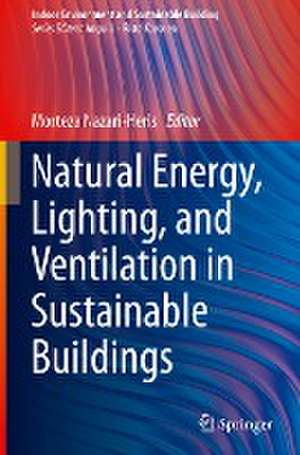Natural Energy, Lighting, and Ventilation in Sustainable Buildings: Indoor Environment and Sustainable Building
Editat de Morteza Nazari-Herisen Limba Engleză Hardback – 17 noi 2023
Natural Energy, Lighting, and Ventilation in Sustainable Buildings offers practical and promising solutions for novel challenges in sustainable design for electrical engineers, energy engineers, architectural engineers, and related professionals, as well asresearchers and developers from engineering science.
Preț: 788.41 lei
Preț vechi: 961.47 lei
-18% Nou
Puncte Express: 1183
Preț estimativ în valută:
150.88€ • 156.94$ • 124.56£
150.88€ • 156.94$ • 124.56£
Carte tipărită la comandă
Livrare economică 14-28 aprilie
Preluare comenzi: 021 569.72.76
Specificații
ISBN-13: 9783031411472
ISBN-10: 3031411471
Pagini: 302
Ilustrații: XV, 302 p. 135 illus., 122 illus. in color.
Dimensiuni: 155 x 235 mm
Greutate: 0.63 kg
Ediția:1st ed. 2024
Editura: Springer Nature Switzerland
Colecția Springer
Seria Indoor Environment and Sustainable Building
Locul publicării:Cham, Switzerland
ISBN-10: 3031411471
Pagini: 302
Ilustrații: XV, 302 p. 135 illus., 122 illus. in color.
Dimensiuni: 155 x 235 mm
Greutate: 0.63 kg
Ediția:1st ed. 2024
Editura: Springer Nature Switzerland
Colecția Springer
Seria Indoor Environment and Sustainable Building
Locul publicării:Cham, Switzerland
Cuprins
Chapter 1. Sustainable Buildings: A Comprehensive Review and Classification of Challenges and Issues, Benefits, and Future Directions.- Chapter 2. The Challenges and Solutions in Sustainable Buildings.- Chapter 3. Introduction and literature review to deployment of photovoltaic systems in buildings.- Chapter 4. Introduction and Literature Review to Deployment of Photovoltaic Systems in Sustainable Buildings.- Chapter 5. Building-integrated photovoltaic (BIPV) and its application, design, and Policy and Strategies.- Chapter 6. Integration of Small-Scale Wind Turbines in Sustainable and Energy Efficient Buildings.- Chapter 7. Operation Optimization of Sustainable Buildings.- Chapter 8. Design of sustainable buildings with renewables.- Chapter 9. Thermal energy storage (TES) for sustainable buildings: addressing the current energetic situation in the EU with TES-enhanced buildings.- Chapter 10. Introduction and Literature Review of the Application of Hydronic-based Radiant Cooling Systemsin Sustainable Buildings.- Chapter 11. Performance Effectiveness of Daylight Modifiers for Optimizing Daylighting in University Buildings.- Chapter 12. Emotional Response to Different Lighting Conditions.
Notă biografică
Dr. Morteza Nazari-Heris is an Assistant Professor at Lawrence Technological University. Before joining Lawrence Tech, he worked as Graduate Research Assistant in Areas of National Need at Pennsylvania State University and earned his Ph.D. specializing in energy systems. During his graduate studies at Penn State, he performed projects on future, flexible, equitable, and robust networks of charging stations for high adoption of electric vehicles, application of machine learning and deep learning methods to energy systems, and sustainable design of buildings with renewable energy sources and energy storage facilities. He has also obtained B.Sc. and M.Sc. degrees in Electrical Engineering from the University of Tabriz, where he worked on design and performance analysis of zero-energy buildings, residential load energy management, and multi-carrier energy systems. Dr. Nazari-Heris has an academic background in the techno-economic-socio analysis of critical infrastructure, including the transportation and energy sectors, life-cycle analysis, and research. During his time as Assistant Professor and Research Assistant, he has delivered four research projects and has authored 63 technical journal articles, 28 conference proceedings papers, and 28 book chapters. In the past decade, he has had a strong background as a researcher in universities in different countries, working on several small-scale projects, which revolved around the power network in different regions, short-term and long-term planning, and optimal energy management systems considering demand and generation side management, load forecasting, optimal power flow, dynamic pricing, sensitivity analysis, and market mechanism design. Dr. Nazari-Heris is an expert in transportation electrification and energy systems, focusing on developing tools for the intelligent, sustainable, and resilient transportation system and energy sector, infrastructure systems, communities, and cities. His main areas of interest are energy system operation, energy management, sustainability, zero-energy Buildings, transportation electrification, electric vehicles, microgrids, multi-carrier energy systems, renewables, and energy storage technologies.
Textul de pe ultima copertă
This book explores the theoretical background and provides an experimental analysis of using natural energy resources in sustainable building design. It brings together an international group of contributors focusing on ways natural energy, lighting, and ventilation can improve the performance of electrical, lighting, and mechanical systems. Contributions explore how natural resources can contribute to sustainable development goals while meeting energy demands and maintaining acceptable interior air quality and natural illumination needs. Coverage includes green building design, renewable energy integration, photovoltaic systems, small-scale wind turbines, natural lighting, and natural ventilation.
- Provides essential research on issues and challenges in green building design.
- Explores the integration of natural energy resources and emerging technologies.
- Includes a cost-saving analysis on the deployment of natural resources.
Caracteristici
Provides essential research on issues and challenges in green building design Explores the integration of natural energy resources and emerging technologies Includes a cost-saving analysis on the deployment of natural resources



